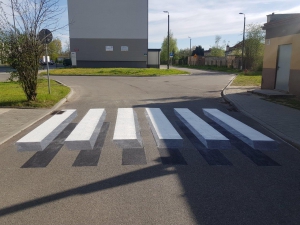A three-dimensional pedestrian crossing was created in Częstochowa

Another three-dimensional pedestrian crossing in Poland was created in Częstochowa, as part of the Hello ICE programme – Budimex programme for children. After Bartoszyce, Lesznowola, Miechów and Sanok, Częstochowa is the fifth city in the country, which will test the popular solution, improving the safety of pedestrians on the road. 3D pedestrian crossings in Częstochowa are just the beginning of similar 2021 investments. In the following months, 3D pedestrian crossings are to be built in at least five locations.
“In 2021, we continue the 3D pedestrian crossing painting pilot project, which last year was met with considerable interest from cities and local governments. It is an innovative solution that has not been very popular in Poland so far. Currently, however, more and more cities are willing to test it, which we are very pleased with, because it confirms the involvement of local governments in the important issue of pedestrian safety on roads”, says Cezary Mączka, Member of the Management Board of Budimex.
The Municipal Road Authority in Częstochowa points out that every action which has a chance of improving pedestrian safety on municipal roads in the future is worth undertaking and testing.
“Due to the lack of appropriate legal regulations in our country, we cannot widely introduce solutions connected with three-dimensional road surface marking on public roads. However, we are in a privileged situation as this pedestrian crossing was created on an internal road leading to such places as our new headquarters”, said Maciej Hasik, the spokesman of the Municipal Road Authority in Częstochowa, who then added, “However, it will not be testing for testing’s sake, because the road is also an access road for the neighbouring institutions. These include a school and educational institutions, so the three-dimensional pedestrian crossing is likely to cause drivers to be more cautious, and it will be helpful for those who travel on foot within our premises.”
As Hasik emphasised, the three-dimensional pedestrian crossing in Częstochowa was constructed right next to a kindergarten, a complex of special needs schools and the headquarters of the Municipal Road Authority, which only emphasises the city’s commitment to promoting good practices and raising awareness about safety among both pedestrians and drivers. Why is it so important?
Mainly because Polish roads are some of the most dangerous in Europe, which is confirmed by statistics. It is enough to say that in 2020 alone, there were 5,235 accidents in Poland involving pedestrians, more than half of which took place at pedestrian crossings. The main causes of these accidents are given as drivers’ failure to yield the right of way to pedestrians and to reduce speed. This is further proof that changes in drivers’ awareness are needed, and the development of road infrastructure by adding three-dimensional pedestrian crossings may be very helpful in this respect.
While in Poland, due to the relatively low popularity of 3D pedestrian crossings, there is a lack of precise information on their effectiveness, we know that the effect of optical illusion used in 3D pedestrian crossings has already proven to be useful in such countries as India and Iceland, where drivers slowed down when seeing 3D road surface markings. The speed of vehicles decreased by 40% on average. So far, in Poland 3D pedestrian crossings have appeared in Lidzbark Warmiński, as well as in the aforementioned Bartoszyce, Lesznowola, Miechów and Sanok, and recently – in Częstochowa.
